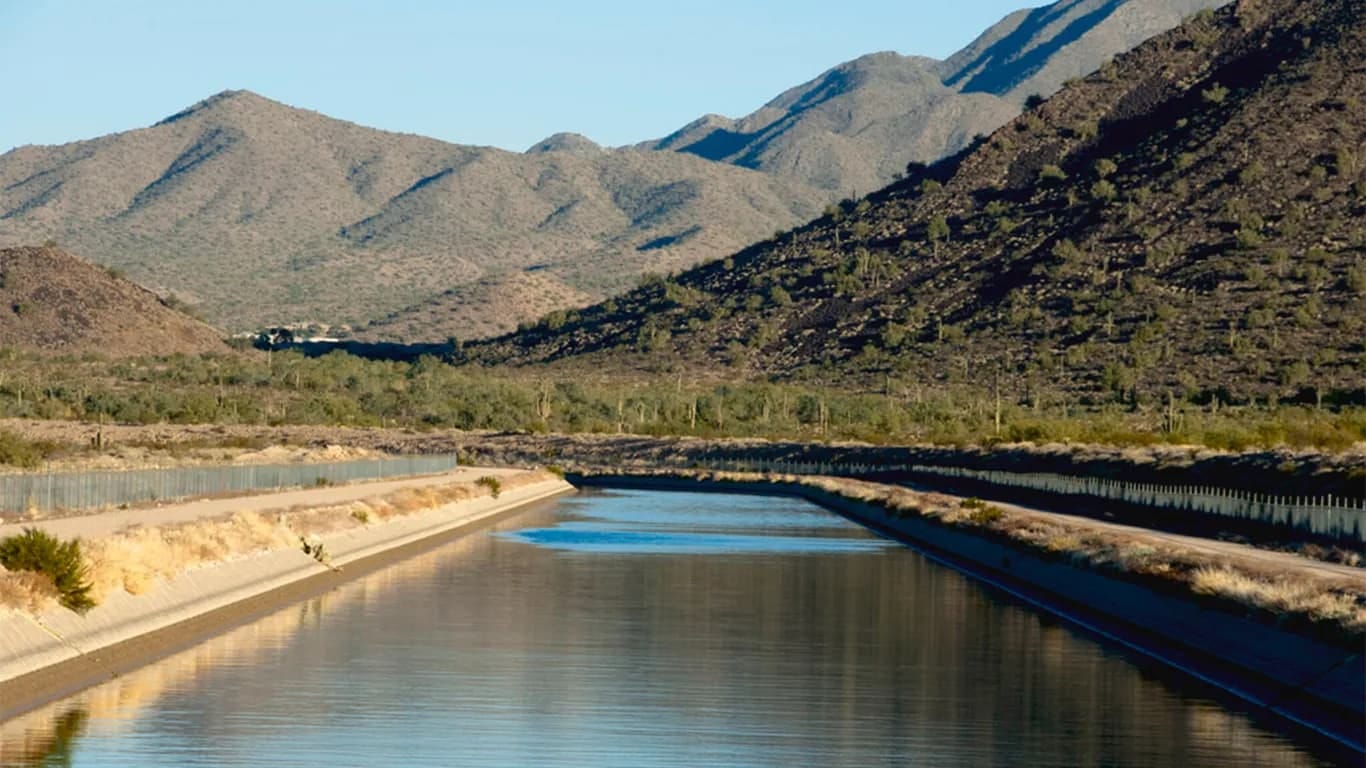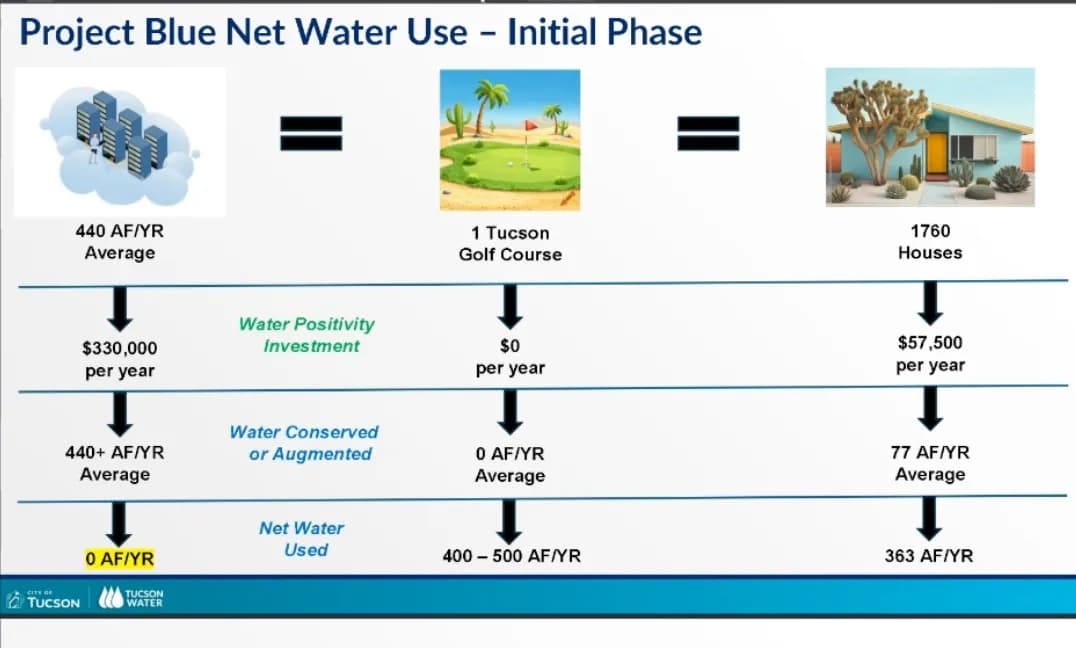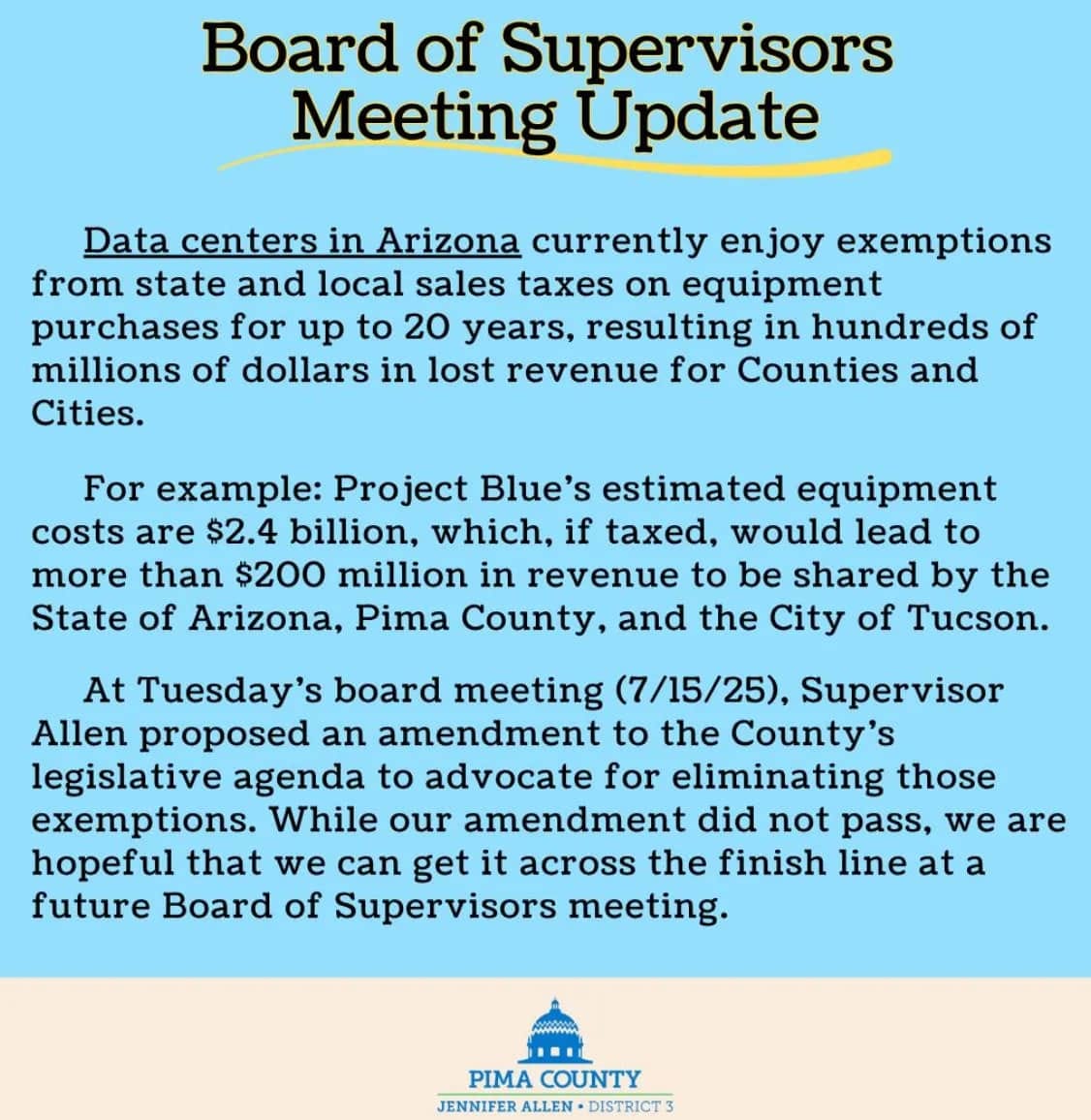The Water Blues
It is a lot of water … Bad audit news … And at least he wore a hairnet.
To paraphrase James Carville: “It’s the water, stupid.”
On Wednesday, the Tucson City Council is expected to spend at least an hour talking — for the first time publicly — about Project Blue and the draft development agreement negotiated between city staff and the project’s authorized representatives.
To be clear, the 40-page agreement has been the focus of community debate for weeks, but the Council hasn’t had the chance to formally weigh in.

We — along with every other journalist in southern Arizona — have tried to get each Council member on the record, but few have been willing to take a definitive stance.1
On Wednesday, we expect everyone on the Council to speak up. But keep in mind that this is not a vote on annexation. That decision is still months away.
Here’s what we know so far:
Project Blue is expected to use up to 143 million gallons of water annually in its initial phase.2
During the first two years of operation, while an 18-mile-long reclaimed water pipeline is under construction and paid for as part of a $100 million investment in infrastructure, Project Blue will rely on potable water.
The current agreement includes clauses to charge more if the developer exceeds the agreed-upon limits, with legal consequences for overuse. But as of now, the city can’t shut off the water supply as long as the developer pays for what it uses.
The agreement also includes a commitment by the developer to fund water-saving initiatives and invest in local infrastructure, like repairing leaking pipes. This is part of a goal for Project Blue to “save” more water than it uses.3
That last piece is a little complicated. The developer can either contribute to a fund for water conservation programs as part of the development agreement or fund its own initiatives.
During Year 1 of these water saving programs, it will be relatively easy to find ways to reduce overall water usage city-wide, but it will be challenging after that. Officials concede there are only so many toilets that can be replaced with newer models that use less water.
Another option on the table? The developer could buy what’s called “paper water” — essentially, the legal right to use water. But environmentalists argue that’s not the same as having actual water flow from your tap, especially during prolonged droughts.
City Manager Tim Thomure says he expects the Council will want to add some hard lines to the agreement — like the power to shut off water if usage becomes a problem.
“For the people that are reading the documents that are on the site, this isn't the last document, this isn't the last decision, this isn't the final word on this. These things are going to change. The cap might be put on water, other restrictions might be put in place, some aspects of it might be renegotiated,” he said.
Everyone on the Council has questions, though Councilwoman Nikki Lee wins the award for most — 120 at last count.
Thomure says he’s hoping to answer as many questions as he can on Wednesday.
Meanwhile, the city expects to see more water flowing back into Tucson Water’s recharge basins.
Since 2023, the city has allowed about 110,000 acre-feet of its Central Arizona Project (CAP) allocation to be sent to Lake Mead. The Bureau of Reclamation has been paying the city $400 per acre-foot, and that agreement still has one year left.
At the time, city officials said they could afford to take the deal because they had been taking more CAP water than they were using — and storing the surplus underground.
Thomure says the city is expected to resume receiving its full CAP allocation in 2027 when the four-year agreement ends.
“The current plan as it stands today is in 2027 and onward, we would go back to full purchase of our allocation. We'd be getting more than we have now. Could that be offset by cuts (in the city’s Colorado River Water allocation)? Potentially, yeah. Most predictions are that we wouldn't be cut below our annual use anytime in the near future,” Thomure said.
The city also struck a deal last week with the Bureau of Reclamation to purchase 21,000 acre-feet of water at a cost of $12.2 million.
Back to Project Blue: Tucson Mayor Regina Romero has added an item to Tuesday’s Council meeting to discuss potential regulations on data centers — similar to steps taken by other cities in the Phoenix metro area.
The two-term mayor says her proposal aims to “mitigate the potential negative impacts of data centers while protecting residents, workers, and ratepayers and preserving natural resources and the environment.”
Romero also emphasized in her newsletter on Friday that there is no set timeline for the Council to vote on Project Blue.
While that’s technically true, the current Council may have an easier time counting to four “yes” votes today than if the annexation vote were taken in January.
All the Democrats running in this week’s City Council primary have signaled their opposition to the project. (And Democrats have an overwhelming voter registration advantage over their Republican opponents in November.)
While unrelated to City Hall, the Pima County Board of Supervisors will also be discussing whether to include a new legislative priority next year: closing a tax loophole that exempts data centers from paying taxes on the equipment inside their massive buildings.
Supervisor Jennifer Allen believes that the loophole could cost the public up to $240 million in the case of Project Blue.
One final note: Beale Infrastructure, the developer behind Project Blue, has hired a PR firm to handle media outreach. That decision comes after months of news coverage and just days before a major public presentation to the Council.
There’s a meeting tonight on Project Blue at the Tucson Convention Center, starting at 5 p.m. You can also watch it on the city’s YouTube channel.
The Council meeting on Wednesday starts at 12:30 p.m. at Tucson City Hall, and will also be broadcast live on YouTube.
An overdue audit from the Arizona Auditor General’s Office just dropped — and it’s not great news for Pima County.
Back in March, we flagged that the county’s audit of federal spending (the Schedule of Expenditures of Federal Awards report) was running late.

Now that it’s in, here’s what state auditors found:
The Grants Management and Innovation Department (GMI) failed to properly monitor and document how federal funds were used, leading to $347,345 in what the agency dubbed “questionable spending.”
GMI didn’t keep key records or report accurate information, as required by federal rules
The department also lacked basic internal controls to track compliance with third parties
(Quick refresher: The head of GMI resigned this spring.)
Staffing inside GMI has long been an issue. A July report stated GMI had 25 vacant positions, out of a total of 43 positions.
There were two other issues mentioned in the report, although those were identified in previous correspondence.
Auditors called out the County Treasurer’s Office for weak IT safeguards, warning that its systems and data are at risk.
State officials also identified issues that “may put its operations and IT systems and data at unintended and unnecessary risk of potential harm.”
The Pima County Board of Supervisors is expected to go over the report at Tuesday’s meeting.
There’s more at stake: While much of the debate over Project Blue data centers has centered on water and electricity, Arizona Daily Star columnist Tim Steller points to larger issues at play, such as a worrying trend of society depending on tech that already “caused major societal rifts, disorders and declines,” the “manic race by Big Tech billionaires to profit off of artificial intelligence no matter the consequences” and an “oligarchy supporting totalitarian tendencies.”
Just up the road: While elected officials in Pima County debate what to do about the Project Blue data centers, the land development company Vermaland announced plans for the state’s largest data center project in Pinal County, the Arizona Republic’s Corina Vanek reports. Construction on the $33 billion, 3,300-acre site (Project Blue is less than 300 acres) near Eloy could start two years from now.
Working out a solution: Local officials are considering a new plan for the Regional Transportation Authority’s $2.7 billion sales tax election, Tucson Sentinel columnist Blake Morlock writes. Time is running out to put the current plan on the ballot for early 2026, so new RTA Executive Director (and former Tucson city manager) Mike Ortega is pushing the idea of combining all the local transportation funds and putting them into a 20-year plan. Then officials would ask voters next year to continue the sales tax for 10 years.
Support local news — no tax increase required.
Border bargaining: Gov. Katie Hobbs wants the federal government to reimburse Arizona for $760 million the state spent on border security since 2021, Capitol Media Services’ Bob Christie reports. The money would come from the $12 billion set aside in the recent federal spending bill to reimburse states for border security costs. In a letter Hobbs sent to the Department of Homeland Security last week, she identified $100 million for the shipping container barrier set up by former Gov. Doug Ducey, along with Hobbs’ border task force and other costs.
This weekend, U.S. Rep. Yassamin Ansari, U.S Sen. Mark Kelly and Pima County Attorney Laura Conover held an “Accountability Summer Town Hall” in Congressional District 6.
As frequent readers might have already guessed, Ansari represents Congressional District 3 in Phoenix, not Southern Arizona’s CD6.
So where was the district’s actual representative, Juan Ciscomani, during the August congressional recess?
Working behind the counter at a local QT, per his Instagram page.
We don’t take sides in political fights, but we do love transparency. A quick shout-out to Councilman Kevin Dahl, who penned a letter to the editor voicing his opposition to Amazon’s Project Blue. We’d say the same thing if someone came out in favor of Project Blue.
This refers to the plan to build four data centers on the 290-acre parcel the developer bought from Pima County near the fairgrounds. “Full” build-out, across two campuses, would require roughly four times that amount.
We struggle to use the term “water-positivity” for a number of reasons, but most importantly, the term seems to suggest that the agreement would create water. It will not. Under the best of circumstances, it will address long-standing issues in the community where the city could do a better job of using — and re-using — the water we have.









Thanks for the reporting on Project Blue! I've been very dissatisfied by the discourse around it. I agree that we need to allocate our natural resources very carefully, and I had no idea about this tax exemption that could keep Pima County from benefiting as much as they could from Project Blue.
In my opinion, the discussions needs to be less about whether or not Project Blue should be allowed, and more about what we should be able to get out of Project Blue if it happens. If Beale really means what they say in the "why Arizona" slide of their PR presentation, then we should be looking to extract as much value out of the data centers as possible. Also, we need to be talking about the resource use in context. Is $750 per acre foot a good cost? Should that just rise with inflation, or should it rise faster than inflation? Also how else can we tax Project Blue? It just seems like there will be a massive amount of money flowing through that project and we need to make sure as much as possible actually flows into Tucson.
Enjoy your summer vacations! Very well deserved, and it looks like ya’ll are going to cooler climates.